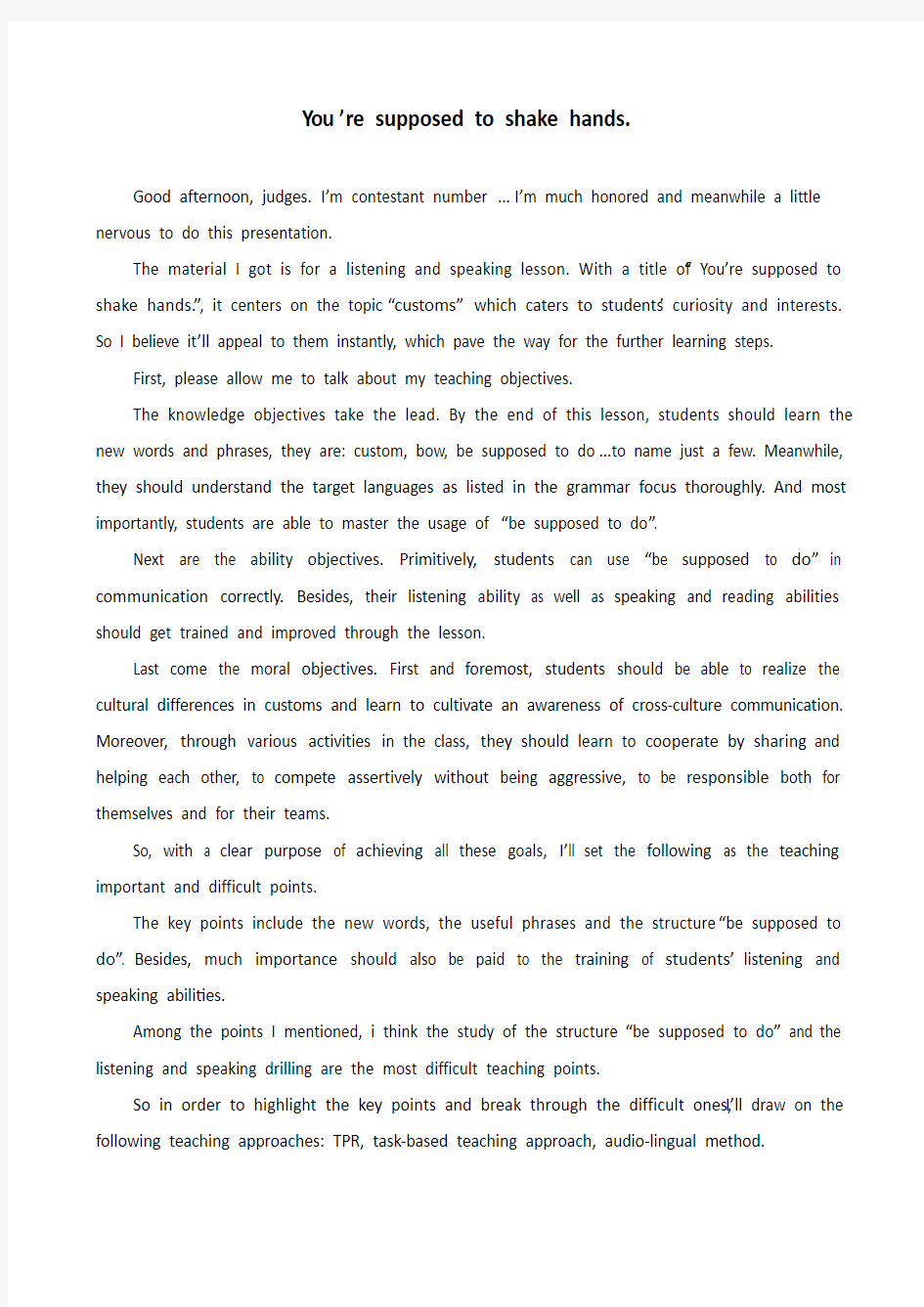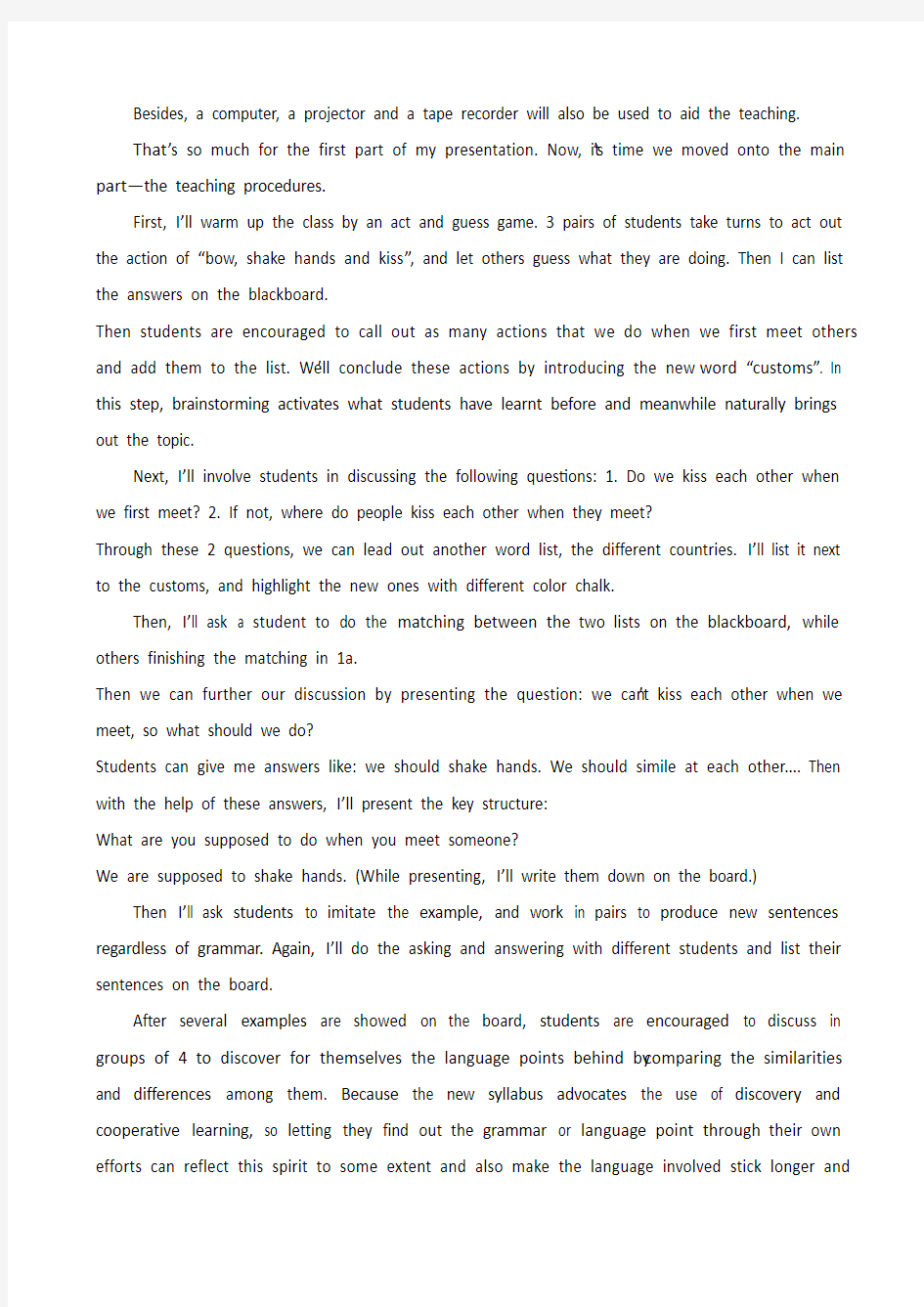Unit 10 You’re supposed to shake hands 说课稿(全英文)


You’re supposed to shake hands.
Good afternoon, judges. I’m contestant number …I’m much honored and meanwhile a little nervous to do this presentation.
The material I got is for a listening and speaking lesson. With a title of “ You’re supposed to shake hands.”, it centers on the topic “customs” which caters to students’ curiosity and interests. So I believe it’ll appeal to them instantly, which pave the way for the further learning steps.
First, please allow me to talk about my teaching objectives.
The knowledge objectives take the lead. By the end of this lesson, students should learn the new words and phrases, they are: custom, bow, be supposed to do…to name just a few. Meanwhile, they should understand the target languages as listed in the grammar focus thoroughly. And most importantly, students are able to master the usage of “be supposed to do”.
Next are the ability objectives. Primitively, students can use “be supposed to do”in communication correctly. Besides, their listening ability as well as speaking and reading abilities should get trained and improved through the lesson.
Last come the moral objectives. First and foremost, students should be able to realize the cultural differences in customs and learn to cultivate an awareness of cross-culture communication. Moreover, through various activities in the class, they should learn to cooperate by sharing and helping each other, to compete assertively without being aggressive, to be responsible both for themselves and for their teams.
So, with a clear purpose of achieving all these goals, I’ll set the following as the teaching important and difficult points.
The key points include the new words, the useful phrases and the structure “be supposed to do”. Besides, much importance should also be paid to the training of students’listening and speaking abilities.
Among the points I mentioned, i think the study of the structure “be supposed to do” and the listening and speaking drilling are the most difficult teaching points.
So in order to highlight the key points and break through the difficult ones, I’ll draw on the following teaching approaches: TPR, task-based teaching approach, audio-lingual method.
Besides, a computer, a projector and a tape recorder will also be used to aid the teaching.
That’s so much for the first part of my presentation. Now, it’s time we moved onto the main part—the teaching procedures.
First, I’ll warm up the class by an act and guess game. 3 pairs of students take turns to act out the action of “bow, shake hands and kiss”, and let others guess what they are doing. Then I can list the answers on the blackboard.
Then students are encouraged to call out as many actions that we do when we first meet others and add them to the list. We’ll conclude these actions by introducing the new word “customs”. In this step, brainstorming activates what students have learnt before and meanwhile naturally brings out the topic.
Next, I’ll involve students in discussing the following questions: 1. Do we kiss each other when we first meet? 2. If not, where do people kiss each other when they meet?
Through these 2 questions, we can lead out another word list, the different countries. I’ll list it next to the customs, and highlight the new ones with different color chalk.
Then, I’ll ask a student to do the matching between the two lists on the blackboard, while others finishing the matching in 1a.
Then we can further our discussion by presenting the question: we can’t kiss each other when we meet, so what should we do?
Students can give me answers like: we should shake hands. We should simile at each other…. Then with the help of these answers, I’ll present the key structure:
What are you supposed to do when you meet someone?
We are supposed to shake hands. (While presenting, I’ll write them down on the board.) Then I’ll ask students to imitate the example, and work in pairs to produce new sentences regardless of grammar. Again, I’ll do the asking and answering with different students and list their sentences on the board.
After several examples are showed on the board, students are encouraged to discuss in groups of 4 to discover for themselves the language points behind by comparing the similarities and differences among them. Because the new syllabus advocates the use of discovery and cooperative learning, so letting they find out the grammar or language point through their own efforts can reflect this spirit to some extent and also make the language involved stick longer and
deeper in their minds. After their primitive findings, I’ll take these conclusions to a more theoretic level and make sure they understand it thoroughly by asking them to give me more sentences.
On finishing the presentation of the new structure, we’ll set our focus on 1c as a review and consolidation of the new knowledge.
Next we’ll move onto the listening in 1b. Listening is one of the most important language skills students should master. So I always value the opportunity of listening practice. We’ll do 1b in this way. First, listen to finish the task and get a general idea. Then for the second listening, students are going to check the answers by reading after the recording, and meanwhile try their best to imitate the pronunciations, intonations and also the way native speakers do in communication. By doing this, their listening ability as well as their speaking competence gets improved.
In the next part, I’ll get students’ attention at the picture in 2a. They are going to predict what happened in the picture and share their opinions with the whole class. I’ll welcome all the things they predict, and affirm the efforts they made to participate, thus encourage more students to take part in class activities. After prediction, we can do the listening in 2a and 2b the same way as we do in 1b. But this time, we’re going to further the activity by asking students to act out the dialogue in 2c, using the information got in the listening.
Having finished the first two pages, we’ll enter into the reading part. Before we read, I’ll present much relevant information about the two countries in the passage to prepare students for the new information. Then get them look at the table below and be clear about their reading task. By reading the exercise first, students are able to read with questions and purposes, which contributes to efficient reading and teaching.
Then we start reading. First, students scan for specific information to finish the table as soon as possible. Then, we’ll check the answers by carrying out the activity called”I’m a recorder”. In this activity, students take turns to read the passage sentence by sentence. Others can stop him/her where they find confusing or important by saying”sorry, I can’t understand here.”This allows students to focus on the details and meanwhile study at their own pace.
Then after finishing reading, comes the pairwork in 3b. Practice is always a necessity. Here it helps students to learn better about the passage they read.
By far, we’ve almost finished all the tasks on the material. Then I need to examine and evaluate how well they master this lesson through a competition called “a very long dialogue”.
How to do that? Students need to make up a dialogue by using the things they learnt in this lesson. The principle is to make the dialogue as long as possible. In order to win the competition, students are going to draw the things leant today as well as learnt previously, to activate their imagination and initiative.
Till now, we are pretty close to the end of the lesson. So we’re going to conclude it by going through the things on the blackboard and read the grammar focus together. Students can feel free to ask questions if they have any.
The homework consists of the following tasks:
1.Do the pairwork in part 4 on page 96.
2.Listen to the dialogue in 1b and 2b for at least once.
Finally, we’ll sing our class goodbye song to end the class in a relaxing way.
This is also the end of my presentation.
Thanks a lot for your time.
